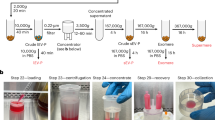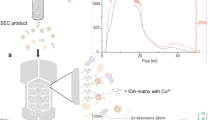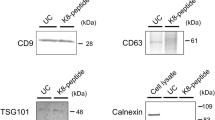Abstract
Macropinocytosis refers to the nonselective uptake of extracellular molecules into many different types of eukaryotic cells within large fluid-filled vesicles named macropinosomes. Macropinosomes are relevant for a wide variety of cellular processes, such as antigen sampling in immune cells, homeostasis in the kidney, cell migration or pathogen uptake. Understanding the molecular composition of the different macropinosomes formed during these processes has helped to differentiate their regulations from other endocytic events. Here, we present a magnetic purification protocol that segregates scarce macropinosomes from other endocytic vesicles at a high purity and in a low-cost and unbiased manner. Our protocol takes advantage of moderate-sized magnetic beads of 100 nm in diameter coupled to mass-spectrometry-based proteomic analysis. Passing the cell lysate through a table-top magnet allows the quick retention of the bead-containing macropinosomes. Unlike other cell-fractionation-based methodologies, our protocol minimizes sample loss and production cost without prerequisite knowledge of the macropinosomes and with minimal laboratory experience. We describe a detailed procedure for the isolation of infection-associated macropinosomes during bacterial invasion and the optimization steps to readily adapt it to various studies. The protocol can be performed in 3 d to provide highly purified and enriched macropinosomes for qualitative proteomic composition analysis.
This is a preview of subscription content, access via your institution
Access options
Access Nature and 54 other Nature Portfolio journals
Get Nature+, our best-value online-access subscription
$29.99 / 30 days
cancel any time
Subscribe to this journal
Receive 12 print issues and online access
$259.00 per year
only $21.58 per issue
Buy this article
- Purchase on Springer Link
- Instant access to full article PDF
Prices may be subject to local taxes which are calculated during checkout







Similar content being viewed by others
Data availability
Human proteome (Uniprot, v20150113) and Salmonella Typhimurium proteome (Uniprot, 99287) were used in the proteomic analysis. All data included in this protocol are openly available and can be found in the public data online repository PRIDE Archive (PXD012825)30. Source data are provided with this paper. The source data files for Fig. 6b–d are also available at online repository figshare (https://doi.org/10.6084/m9.figshare.14183024 and https://doi.org/10.6084/m9.figshare.14183090, respectively) and in the supporting primary research article30.
References
Ha, K. D., Bidlingmaier, S. M. & Liu, B. Macropinocytosis exploitation by cancers and cancer therapeutics. Front. Physiol. 7, 381–381 (2016).
Kumari, S., Mg, S. & Mayor, S. Endocytosis unplugged: multiple ways to enter the cell. Cell Res. 20, 256–275 (2010).
Naslavsky, N. & Caplan, S. The enigmatic endosome—sorting the ins and outs of endocytic trafficking. J. Cell Sci. 131, jcs216499 (2018).
Garcia-Castillo, M. D., Chinnapen, D. J. & Lencer, W. I. Membrane transport across polarized epithelia. Cold Spring Harb. Perspect. Biol. 9 (2017).
Joel, A. S. & Jason, S. K. The breadth of macropinocytosis research. Philos. Trans. R. Soc. Lond. B Biol. Sci. 374, 20180146 (2019).
Lewis, W. H. Pinocytosis by malignant cells. Am. J. Cancer Res. 29, 666–679 (1937).
Egami, Y., Taguchi, T., Maekawa, M., Arai, H. & Araki, N. Small GTPases and phosphoinositides in the regulatory mechanisms of macropinosome formation and maturation. Front. Physiol. 5, 374 (2014).
Kühn, S., Lopez-Montero, N., Chang, Y. Y., Sartori-Rupp, A. & Enninga, J. Imaging macropinosomes during Shigella infections. Methods 127, 12–22 (2017).
Jayashankar, V. & Edinger, A. L. Macropinocytosis confers resistance to therapies targeting cancer anabolism. Nat. Commun. 11, 1121 (2020).
Redelman-Sidi, G. et al. The canonical Wnt pathway drives macropinocytosis in cancer. Cancer Res. 78, 4658–4670 (2018).
Li, Y. et al. Macropinocytosis-mediated membrane recycling drives neural crest migration by delivering F-actin to the lamellipodium. Proc. Natl Acad. Sci. USA 117, 27400 (2020).
Freeman, S. A. et al. Lipid-gated monovalent ion fluxes regulate endocytic traffic and support immune surveillance. Science 367, 301–305 (2020).
Palm, W. Metabolic functions of macropinocytosis. Philos. Trans. R Soc. Lond. B Biol. Sci. 374, 20180285–20180285 (2019).
Canton, J. Macropinocytosis: new insights into its underappreciated role in innate immune cell surveillance. Front. Immunol. 9 (2018).
Liu, Z. & Roche, P. A. Macropinocytosis in phagocytes: regulation of MHC class-II-restricted antigen presentation in dendritic cells. Front. Physiol. 6, 1 (2015).
Kerr, M. C. & Teasdale, R. D. Defining macropinocytosis. Traffic 10, 364–371 (2009).
Jones, A. T., Gumbleton, M. & Duncan, R. Understanding endocytic pathways and intracellular trafficking: a prerequisite for effective design of advanced drug delivery systems. Adv. Drug Deliv. Rev. 55, 1353–1357 (2003).
Buckley, C. M. & King, J. S. Drinking problems: mechanisms of macropinosome formation and maturation. FEBS J. 284, 3778–3790 (2017).
Joel, A. S. & Sei, Y. Macropinosomes as units of signal transduction. Philos. Trans. R. Soc. Lond. BBiol. Sci. 374, 20180157 (2019).
Ford, C., Nans, A., Boucrot, E. & Hayward, R. D. Chlamydia exploits filopodial capture and a macropinocytosis-like pathway for host cell entry. PLoS Pathog. 14, e1007051 (2018).
Lee, C. H. R., Mohamed Hussain, K. & Chu, J. J. H. Macropinocytosis dependent entry of Chikungunya virus into human muscle cells. PLoS Negl. Trop. Dis. 13, e0007610 (2019).
Kälin, S. et al. Macropinocytotic uptake and infection of human epithelial cells with species B2 adenovirus type 35. J. Virol. 84, 5336–5350 (2010).
Torriani, G. et al. Macropinocytosis contributes to hantavirus entry into human airway epithelial cells. Virology 531, 57–68 (2019).
Helenius, A. Virus entry: looking back and moving forward. J. Mol. Biol. 430, 1853–1862 (2018).
Mercer, J. & Helenius, A. Virus entry by macropinocytosis. Nat. Cell Biol. 11, 510–520 (2009).
Hetzenecker, S., Helenius, A. & Krzyzaniak, M. A. HCMV induces macropinocytosis for host cell entry in fibroblasts. Traffic 17, 351–368 (2016).
Garcia-del Portillo, F. & Finlay, B. B. Salmonella invasion of nonphagocytic cells induces formation of macropinosomes in the host cell. Infect. Immun. 62, 4641–4645 (1994).
Weiner, A. et al. Macropinosomes are key players in early Shigella invasion and vacuolar escape in epithelial cells. PLoS Pathog. 12, e1005602 (2016).
Fredlund, J. et al. The entry of Salmonella in a distinct tight compartment revealed at high temporal and ultrastructural resolution. Cell. Microbiol. 20 (2018).
Stévenin, V. et al. Dynamic growth and shrinkage of the Salmonella-containing vacuole determines the intracellular pathogen niche. Cell Rep 29, 3958–3973.e3957 (2019).
Chang, Y.-Y., Enninga, J. & Stévenin, V. New methods to decrypt emerging macropinosome functions during the host–pathogen crosstalk. Cell. Microbiol. 23, e13342 (2021).
Chang, Y.-Y. et al. Shigella hijacks the exocyst to cluster macropinosomes for efficient vacuolar escape. PLoS Pathog 16, e1008822 (2020).
de Araújo, M. E. G., Lamberti, G. & Huber, L. A. Isolation of early and late endosomes by density gradient centrifugation. Cold Spring Habor Protoc. 2015, pdb.prot083444 (2015).
Kobayashi, T. et al. Separation and characterization of late endosomal membrane domains. J. Biol. Chem. 277, 32157–32164 (2002).
Tjelle, T. E., Brech, A., Juvet, L. K., Griffiths, G. & Berg, T. Isolation and characterization of early endosomes, late endosomes and terminal lysosomes: their role in protein degradation. J. Cell Sci. 109, 2905–2914 (1996).
Walker, L. R., Hussein, H. A. & Akula, S. M. Subcellular fractionation method to study endosomal trafficking of Kaposi’s sarcoma-associated herpesvirus. Cell Biosci. 6, 1 (2016).
Plouffe, B. D., Murthy, S. K. & Lewis, L. H. Fundamentals and application of magnetic particles in cell isolation and enrichment: a review. Rep. Prog. Phys. 78, 016601–016601 (2015).
Wittrup, A. et al. Magnetic nanoparticle-based isolation of endocytic vesicles reveals a role of the heat shock protein GRP75 in macromolecular delivery. Proc. Natl Acad. Sci. USA 107, 13342–13347 (2010).
Miltenyi, S., Muller, W., Weichel, W. & Radbruch, A. High gradient magnetic cell separation with MACS. Cytometry 11, 231–238 (1990).
Özbaykal, G. et al. The transpeptidase PBP2 governs initial localization and activity of the major cell-wall synthesis machinery in E. coli. eLife 9, e50629 (2020).
Vigouroux, A. et al. Class-A penicillin binding proteins do not contribute to cell shape but repair cell-wall defects. eLife 9, e51998 (2020).
Haigler, H. T., McKanna, J. A. & Cohen, S. Rapid stimulation of pinocytosis in human carcinoma cells A-431 by epidermal growth factor. J. Cell Biol. 83, 82–90 (1979).
Fujii, M., Kawai, K., Egami, Y. & Araki, N. Dissecting the roles of Rac1 activation and deactivation in macropinocytosis using microscopic photo-manipulation. Sci. Rep. 3, 2385 (2013).
Nakase, I. et al. Cellular uptake of arginine-rich peptides: roles for macropinocytosis and actin rearrangement. Mol. Ther. 10, 1011–1022 (2004).
Al-Taei, S. et al. Intracellular traffic and fate of protein transduction domains HIV-1 TAT peptide and octaarginine. implications for their utilization as drug delivery vectors. Bioconjug. Chem. 17, 90–100 (2006).
Nakase, I. et al. Interaction of arginine-rich peptides with membrane-associated proteoglycans is crucial for induction of actin organization and macropinocytosis. Biochemistry 46, 492–501 (2007).
D’Astolfo, D. S. et al. Efficient intracellular delivery of native proteins. Cell 161, 674–690 (2015).
Hetrick, B. et al. Small molecules CK-666 and CK-869 inhibit actin-related protein 2/3 complex by blocking an activating conformational change. Chem. Biol. 20, 701–712 (2013).
Koivusalo, M. et al. Amiloride inhibits macropinocytosis by lowering submembranous pH and preventing Rac1 and Cdc42 signaling. J. Cell Biol. 188, 547–563 (2010).
Ivanov, A.I. Pharmacological inhibition of endocytic pathways: is it specific enough to be useful? in Exocytosis and Endocytosis (ed. Ivanov, A. I.) 15–33 (Humana Press, 2008).
Addi, C. et al. The Flemmingsome reveals an ESCRT-to-membrane coupling via ALIX/syntenin/syndecan-4 required for completion of cytokinesis. Nat. Commun. 11, 1941 (2020).
Rizzo, J. et al. Characterization of extracellular vesicles produced by Aspergillus fumigatus protoplasts. mSphere 5, e00476–00420 (2020).
Lelouard, H. et al. Pathogenic bacteria and dead cells are internalized by a unique subset of Peyer’s patch dendritic cells that express lysozyme. Gastroenterology 138, 173–184.e171-173 (2010).
Tyanova, S., Temu, T. & Cox, J. The MaxQuant computational platform for mass spectrometry-based shotgun proteomics. Nat. Protoc. 11, 2301–2319 (2016).
Cox, J. & Mann, M. MaxQuant enables high peptide identification rates, individualized p.p.b.-range mass accuracies and proteome-wide protein quantification. Nat. Biotechnol. 26, 1367–1372 (2008).
Wieczorek, S. et al. DAPAR & ProStaR: software to perform statistical analyses in quantitative discovery proteomics. Bioinformatics 33, 135–136 (2017).
Giai Gianetto, Q., Wieczorek, S., Couté, Y. & Burger, T. A peptide-level multiple imputation strategy accounting for the different natures of missing values in proteomics data. Preprint at bioRxiv https://doi.org/10.1101/2020.05.29.122770 (2020).
Giai Gianetto, Q. et al. Calibration plot for proteomics: a graphical tool to visually check the assumptions underlying FDR control in quantitative experiments. Proteomics 16, 29–32 (2016).
Ritchie, M. E. et al. limma powers differential expression analyses for RNA-sequencing and microarray studies. Nucleic Acids Res. 43, e47 (2015).
Mi, H., Muruganujan, A., Ebert, D., Huang, X. & Thomas, P. D. PANTHER version 14: more genomes, a new PANTHER GO-slim and improvements in enrichment analysis tools. Nucleic Acids Res. 47, D419–D426 (2018).
Santos, J. C. et al. The COPII complex and lysosomal VAMP7 determine intracellular Salmonella localization and growth. Cell. Microbiol. 17, 1699–1720 (2015).
Ibarra, J. A. et al. Induction of Salmonella pathogenicity island 1 under different growth conditions can affect Salmonella-host cell interactions in vitro. Microbiology 156, 1120–1133 (2010).
Steele-Mortimer, O. Infection of epithelial cells with Salmonella enterica. in Bacterial Pathogenesis: Methods and Protocols (eds. DeLeo, F. R. & Otto, M.) 201–211 (Humana Press, 2008).
Li, L. et al. The effect of the size of fluorescent dextran on its endocytic pathway. Cell Biol. Int. 39, 531–539 (2015).
Acknowledgements
The authors thank V. Sohst and N. Reiling (Research Center, Borstel, Germany) for the enthusiasm and great help at the initial stages of this project. Y-Y.C was supported by a fellowship from the Fondation pour la Recherche Médicale (FRM; SPF20160936275). V.S. was supported by a PhD fellowship from the University Paris Diderot (now Université de Paris) allocated by the ENS Paris-Saclay, a grant from the FRM (FRM; FDT20170436843), and an extension grant from the BCI Department of Institut Pasteur. J.E. is a member of the LabEx consortia IBEID and MilieuInterieur. J.E. also acknowledges support from the ANR (grant StopBugEntry and AutoHostPath) and the ERC (CoG EndoSubvert).
Author information
Authors and Affiliations
Contributions
V.S. and Y-Y.C. developed the protocol with input from J.E. V.S. and Y-Y.C. performed the experiments and wrote the manuscript. M.D. and Q.G.G. acquired data, performed analysis and wrote the manuscript. M.M. and J.E. supervised the study, provided feedback on the manuscript and secured funding.
Corresponding authors
Ethics declarations
Competing interests
The authors declare no competing interests.
Additional information
Peer review information Nature Protocols thanks the anonymous reviewers for their contribution to the peer review of this work.
Publisher’s note Springer Nature remains neutral with regard to jurisdictional claims in published maps and institutional affiliations.
Related links
Key references using this protocol
Stévenin, V. et al. Cell Rep. 19, 3958–3973.e7 (2019): https://doi.org/10.1016/j.celrep.2019.11.049
Chang, Y. Y. et al. PLoS Pathog. 16, e1008822 (2020): https://doi.org/10.1371/journal.ppat.1008822
Chang, Y. Y. et al. Cell. Microbiol. 23, e13342 (2021): https://doi.org/10.1111/cmi.13342
Supplementary information
Source data
Source Data Fig. 6
Unprocessed gel (stained with Coomassie Blue)
Rights and permissions
About this article
Cite this article
Stévenin, V., Giai Gianetto, Q., Duchateau, M. et al. Purification of infection-associated macropinosomes by magnetic isolation for proteomic characterization. Nat Protoc 16, 5220–5249 (2021). https://doi.org/10.1038/s41596-021-00610-5
Received:
Accepted:
Published:
Issue Date:
DOI: https://doi.org/10.1038/s41596-021-00610-5
Comments
By submitting a comment you agree to abide by our Terms and Community Guidelines. If you find something abusive or that does not comply with our terms or guidelines please flag it as inappropriate.



